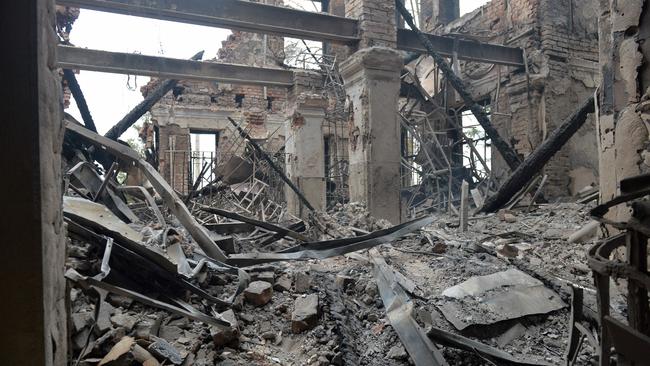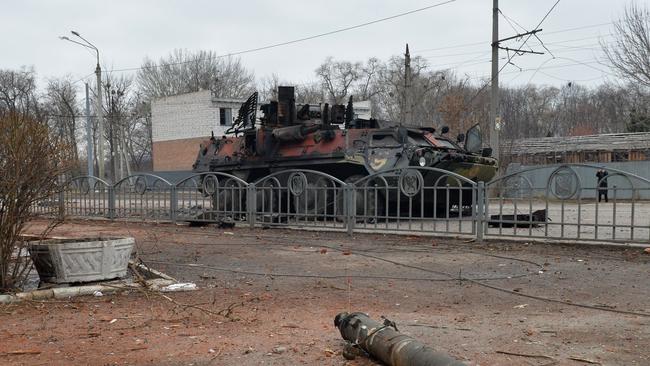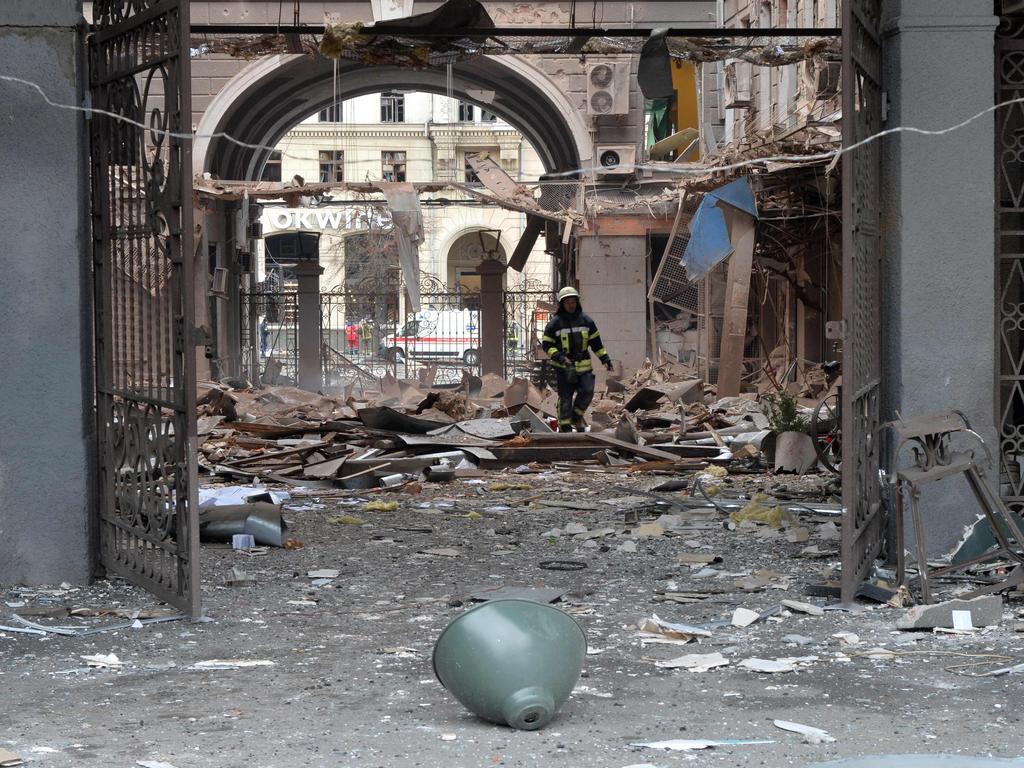A wake-up call for the West: we need to beef up our defence
Russia’s invasion is the most powerful wake-up call to Western strategic complacency since the Vietnam War. We are among the least prepared.

Moscow’s brutal war crimes in Ukraine are a much bigger deal than the 9/11 terror attacks and bigger than any internal act of Chinese government repression. They demonstrate the weakness of the rules-based international order, the return to dominance of great-power politics, the willingness of a major nuclear power to wage a conventional and savage war of invasion and conquest in the European heartland.
The Russia-Ukraine war also contains specific military lessons.
The first is that a threat can materialise in weeks, days, perhaps even hours. Defence emergencies are all come-as-you-are. Nobody can rely on strategic warning times.
The next lesson is about being attacked by a much bigger nation. Ukraine, with 44 million people and land the size of France, is not a small nation. But Russia is much bigger.
Moscow can choose war because it can bear its own casualties and Ukraine doesn’t have offensive weapons. Regarding Russia, Ukraine lacks strategic strike. The calculus in Moscow would have been different if Kyiv had possessed 10,000 missiles that could hit any part of Russia, including the Kremlin.
This conflict demonstrates clearly that we live in the age of missiles. Western nations wickedly refused to supply Ukraine with relevant weaponry in advance. Ukraine’s heroic military and people are wildly overmatched, yet they have inflicted substantial losses on Russian forces through portable, cheap, shoulder-launched missiles, Javelin anti-tank missiles and Stinger anti-aircraft missiles.
Say it again: we are living in the missile age.
All these lessons apply to Australia but we are not taking notice of them. We’ve been brave in expressing solidarity for Ukrainians. If Churchillian rhetoric and grand pronouncements provided national security, we would be the safest nation in the world.
But the Australian Defence Force is almost insanely structured to meet none of our strategic needs, to take no notice of profound changes in our security environment and the modern ways of war.

The Defence Strategic Update of 2020 recognised that we no longer have a strategic notice period of 10 years, that state-on-state conflict is the dominant new reality and that we need to develop strike capabilities to deter potential enemies.
Yet here we are, the world’s 13th biggest economy and the 13th biggest defence spender. Yet not one of our services – navy, air force or army – has any strategic strike. Every one of our major defence programs is in disarray or scheduled to deliver capability so far into the future that it’s in the realm of science fiction, or delivers assets that have no weapons on them (yes, that’s true, as I’ll explain), or is completely irrelevant to the maritime military challenge we face.
At the same time, our strategic fuel reserve is kept in the US, meaning we would not have access to it in an emergency. There are almost no Australian-flagged cargo vessels, so nothing a government could press into service in a crisis.
Though Scott Morrison and other leaders constantly tell us the strategic environment has worsened, we are less well defended than 20 years ago, or 40 years ago. Once we had strategic strike through our F111 fighter-bombers. Once we had numerous oil refineries and plenty of fuel. Once we spent much more of our gross national product on defence and had a much bigger ADF. In pre-cyber days, with less sophisticated missiles about, our location and size gave us much greater security.
The Whitlam government spent 2.4 per cent of GNP on defence. The Morrison government spends just 2.1 per cent, way behind even the Brits, though the Brits have nuclear weapons and are surrounded by allies.
Marcus Hellyer of the Australian Strategic Policy Institute captures the absurdity of our situation. In the 2020s decade the government plans to spend $575bn on defence, including $270bn on new equipment acquisitions. In that whole period we do not get one new warship or one new missile vertical launch cell. That is beyond parody. The writers of Yes Minister were amateurs compared with the heroes of Canberra’s Fort Fumble. They merely imagined a hospital without patients. Canberra spends nearly $600bn and produces neither warship nor missile cell. That’s perversely impressive.

The key is we have not designed the ADF to fight the militaries of other nations. We have been so dependent on the US for so long we have an acquired helplessness.
We have the same force structure as we developed under Robert Menzies in the early 1960s. The Australian Defence Organisation, in classic bureaucratic style, has simply reproduced itself over and over again, like an amoeba growing without a central nervous system. We have not had a defence minister who can seriously imagine a different Defence structure since Kim Beazley in the ’80s.
The ADF is structured to do local constabulary work – arresting illegal fishermen, preventing boatpeople arrivals, some modest regional peacekeeping – and to deploy in extremely modest niche roles with the Americans, mainly in the Middle East.
We are not remotely structured to cope with today’s maritime challenges in the Indo-Pacific. Our force structure is an endless compromise of inter-service horse trading, weak and transient defence ministers and a stubborn refusal to prioritise genuine combat capabilities that could succeed against another state. The core task of all militaries is to close with and destroy the enemy. Without the Americans doing the fighting for us, there is no state enemy we could close with and destroy.
We have wasted, and continue to waste, billions and billions of dollars on capability that is not relevant or not capable of any military effect.
This is not aimed at the Morrison government alone. The Prime Minister understands security issues and should be able to rely on the system to give him better options. Peter Dutton is a good defence minister working through disastrous legacy problems. But neither they nor their predecessors have been able or willing to provide a defence force structure that remotely answers the strategic circumstances both sides of politics routinely invoke. Both sides of politics are equally guilty. We spend $42bn of largely unexamined money in wasteful and misguided ways.
We need immediate or short-term action and a radical new plan for the longer term. First, we should make our existing platforms much more lethal. Second, we should restructure the ADF.
All of our major defence programs are in disarray, militarily irrelevant or time horizon irrelevant. Take them one by one, navy first. We have three main navy ship types - offshore patrol vessels, frigates and destroyers, and submarines.

We get a lot of our best defence information through Senate estimates and Auditor-General’s reports. An auditor’s report recently contained an astonishing revelation about our OPVs, of which we are building 12. It said: “In June 2021 due to technical certification concerns by navy, a revised threat assessment and a requirement for commonality” the OPV builder, Luerssen, was required to scrap the 40mm gun due to go on the OPVs and install a 25mm gun instead. What possible new threat assessment makes you want a smaller gun?
The new OPVs are big ships, 80m long and nearly 2000 tonnes. Yet the utterly pathetic 25mm gun is the same size as we’ve had on all our old patrol boats for decades. We’ve built a vastly bigger ship and put no weapons on it at all.
The OPVs are as big as a corvette or a small frigate. Ships that size all around the world contain many lethal weapons. These same OPVs as ours, operated by other navies, contain anti-ship missiles. Luerssen builds a 90m version. It could easily take both anti-ship missiles and an air defence system.
When Chinese navy vessels recently “painted” an Australian P8 Poseidon surveillance aircraft with a laser, which is often preparatory to hostile action, we sent an older patrol boat to track the Chinese ship. Under no circumstances could our patrol vessels do any harm to a competent foreign navy ship. But if we had anti-ship and other missiles on our OPVs, we would effectively double our surface combatant fleet. That we don’t have missiles on the OPVs is the consequence of an insane internal bureaucratic battle.
Then there are the nine Hunter-class anti-submarine warfare frigates we plan to build. The navy was told to choose a mature design and make minimum changes. So it naturally rejected the Italian Fremm, which actually exists and was chosen by the US navy. It naturally rejected the Navantia bid, which would have used the hull we were familiar with building for our air warfare destroyers. Instead, prisoners of their deepest pathologies, the navy chose the British Type 26 frigate, which is still not finished with its design work even today and is not yet in service in the British navy.
We made so many modifications the notional frigate now weighs 10,000 tonnes and will be slow, cumbersome and uncompetitive. It will have a pitiful 32 vertical launch cells to fire missiles and only one helicopter to hunt subs. As an ASPI report observed: “Of all contemporary warships, it seems to be the most expensive for getting missiles to sea.” The project is already delayed by years. It will be a miracle if the first Hunter comes into service by the mid-2030s.
If it weren’t for the diplomatic cost of upsetting the Brits, there is substantial sentiment to cancel the Hunter frigate.

In 2007 John Howard wanted to buy the US Arleigh Burke-class destroyer but succumbed to cabinet and non-navy defence leaders preferring the smaller AWD. The Arleigh Burke is magnificent – 96 vertical launch cells and two anti-sub helicopters. No need for modifications. Whoever wins the next election should scrap the Hunters and buy Arleigh Burkes.
Then there’s subs. I support the AUKUS agreement and the promise of nuclear powered subs. There is no chance they will be built in Adelaide. Both the Americans and the Brits are moving to new nuclear sub designs. Given all the massive development necessary, even if everything goes perfectly well, we won’t get new nuclear subs until 2040 or probably later. We might conceivably get to lease an old one in seven or eight years time, but one training boat is not a military capability.
Both Australian defence industry companies, and an intelligent trade union movement, strongly back building six new Collins-class subs with no or absolutely minimal design variation from the existing Collins subs. They would be a transition to nuclear-powered subs. A new government should do that urgently. Otherwise our declining sub capability exposes us now and will expire altogether by the late 2030s.
Then there’s the army. We are wasting billions of dollars on new tanks and tens of billions of dollars on heavy armoured vehicles that can never be used in any regional maritime context. Why? Because that’s what we’ve always done. And because these vehicles are good for expeditionary deployments with Americans in the Middle East.
The army urgently needs to completely reconfigure itself. It should acquire thousands of long-range, land-launched missiles. Hezbollah, a terrorist guerrilla group, has 100,000 missiles and constitutes an existential threat to Israel. We acquire missiles in the dozens if we’re lucky and are a threat to nobody.
Long-range ground-based missiles can be based in mobile launchers mostly around northern Australia. The army, following the US marines who are refashioning themselves for Asian maritime combat, could move in small formations with these small mobile launchers on relatively small craft anywhere in Southeast Asia. That provides strike and flexibility, and many mobile launchers are hard for an enemy to detect or destroy.
For missiles to work strategically, you need thousands of them. Donald Trump fired 70 Tomahawks – as many as we’ll have in our whole fleet once they’re on AWDs and the Collins subs and our few Super Hornets – at a Syrian air base and it was back operating again in a day or two.
Land-based Tomahawks, with a range of 1600km or more, will be available from next year at about $2m each. You could have 2000 of them for $4bn. That would make any potential aggressor think twice before engaging Australia. The number could gradually build to several thousand.
The air force, which has a pitiful 80 fast jets to secure the whole of Australia and its maritime approaches, needs to be twice its current size and equipped with lots of long-range missiles. Our whole defence force must be much bigger.
We need lots of lethal maritime drones, lots of smart sea mines to potentially restrict an enemy’s movement, a vastly bigger de-mining capability in case an enemy does that to us. We need unmanned underwater vehicles and pilotless planes. All these capabilities, but especially missiles, shouldn’t be marginal add-ons to our irrelevant legacy assets. They must become core.
We could do all this, with not all that much more money than we are spending now, certainly nothing like the countless billions we have flushed down the drain during Covid. And if we did all this, we would be, militarily, a formidable middle power. But we would have to get rid of a lot of the legacy junk that sustains careers and certain types of bragging rights (our tanks are the biggest!).
Our rhetoric about Ukraine is infinitely less important than learning the real lessons of Ukraine, which we show no sign of doing. The most important lesson is that we need to be able to look after ourselves. Alternatively, we could persist with the current approach, in which case we should at least supplement it with molotov-cocktail-making classes in the suburbs.





The Russian invasion of Ukraine is the most powerful, shocking wake-up call to Western strategic complacency since the end of the Vietnam War. Yet Australia, despite the lofty rhetoric, shows no signs of taking this historic wake-up call seriously. Of all nations in the Western alliance we are long term among the most vulnerable and the least prepared.